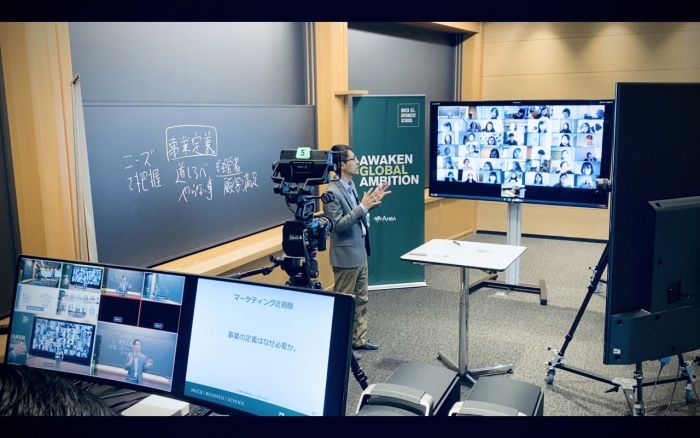Online education and live virtual courses
Live virtual courses
There are two types of online classes: synchronous (live virtual) and asynchronous (on-demand), both of which are becoming established as enhanced teaching methods with the advancement of communication technology. The former of the two was mainly operated by connecting classrooms to each other. By installing high-speed communication lines and teleconferencing equipment at each location, a method to provide high quality live courses in real time has been established. In the past, these systems were extremely expensive, ranging from several million yen to tens of millions of yen per set, and were used by foreign companies for their board meetings. However, in recent years, they have become affordable and available for personal use.
The asynchronous type of online learning involves on-demand delivery of recorded learning materials. These can be accessed by anyone with an internet connection at any time, and can be watched to earn credits or certificates by attending additional lectures and passing exams. These innovations in learning have made a significant contribution to the availability of education for those who with difficulties in commuting to a school campus.
Are online classes more or less effective for education?
For those of us who are used to classroom teaching, it takes some time to get used to distance learning. At the very least, both can be effective media of education, and should be offered with the utmost care and attention for best results. Institutions of education must continue to improve on these methods while carefully examining their contribution to the School's mission.
As for educational effectiveness, the opinions of the faculty and students who provide the service are valuable, but it is also important to be aware of the evaluations of the companies that hire graduates of these programs. It will take time to verify the results, but the majority of positive opinions at this stage indicate that live virtual courses are capable of producing results in students.
Online Classes Reveal Teaching Ability
On the other hand, negative opinions about the introduction of online classes often come from teachers who have lack adaptability in their teaching. For teachers who are used to one-sidedly reading their own theories or textbooks without any interest in the participants' level of understanding or interaction with them, the idea of taking an online class can be intimidating. Yes, the introduction of online classes lay bare the teaching ability of lecturers. It is up to those educators to decide whether they will thrive or perish as education is increasingly influenced by technological innovation.
Misconceptions about online classes
In considering what an online class is, we can first categorize the methods of class delivery offered by educational institutions as follows. To what extent can we call them "classes" in the first place? In online classes, extremely high quality live virtual classes (B) are common in business schools around the world, where participants and instructors interact freely and simultaneously, and the learning effect is equal to or greater than that of face-to-face classes in a classroom. Naturally, grading can also be conducted in the same style as on-campus classes, which emphasize class contribution.
- Face-to-face teaching in classrooms (A - classroom type)
- Live virtual classes (B - Live type) MEXT: Media Class Notification No. 1
- Asynchronous delivery class (C - recorded type) MEXT: Media Class Notification No. 2
- Material-based class (D - Other)
Courses delivered using methods in category D are much like a "picture-story show" with voiceovers infused into presentation materials. On-demand sounds like a good way to describe asynchronous delivery, but categories C and D are practically indistinguishable from one another. Unfortunately, the vast majority of what are now called online classes are conducted in combination with audio slide materials and assignment submissions that could be classified under category
Remote learning with Learning Management Systems (LMS) supplements live virtual delivery with a web service for distributing teaching materials, communicating with students, and exchanging opinions, much like a bulletin board in a classroom. It is a tool to support preparation and review outside the classroom. Therefore, LMSs are used to supplement face-to-face classes in the classroom or remotely, and are always used in courses categorized as A, B, and C courses, whereas courses in category D rely entirely on the LMS as a vehicle of instruction.
Live virtual courses and asynchronous courses
Unlike asynchronous courses, live virtual courses (simultaneous interactive) are capable of providing a classroom atmosphere. In the past, it was common for teachers to provide classes remotely by connecting classrooms. However, with the development of video compression technology, faster internet connections, and the birth of cloud-based video conferencing systems, it has become possible to deliver high-quality, low-latency video using personal computers, connecting individuals in a live network that becomes a remote classroom.
On the other hand, asynchronous courses consist of an educational system and educational contents. The former refers to the learning management system (LMS), while the latter refers to the educational materials (mainly videos). Both the former and the latter are sold as E-Learning materials on a commercial basis, and while E-Learning tends to be associated with the concept of "teacherless education," recent advances in web technology have brought it to the level of providing participatory learning experiences. In 2012, edX and Coursera released higher education content for free and triggered a reevaluation of the value of E-Learning.
There is a movement to refer to massive online open courses (MOOCs) as online classes, but the MOOC system is a combination of video distribution and bulletin board functions. Passively watching video recordings with no element of participation devalues the teaching and learning methods of higher education, which have been cultivated throughout human history. The Small Private Online Course (SPOC), which can be called a competitor to MOOCs, is the only viable option for educational pursuits. The mission of higher education is to provide an emergent and real place for the exchange of opinions between faculty and participants, and between participants themselves. With careful attention to simulating how this is achieved, online courses can achieve that mission, but not all types of online courses are created equal.
Global trends in online classes (Live Virtual)
There has been a movement around the world to explore live virtual classes, a prime example being HBX (2014), developed by Harvard Business School. With faculty members delivering live case method courses in front of a giant screen being watched by staff members operating AV equipment, the setup in a cable TV studio in Boston resembled a newsroom. The studio model is being replicated on their campus and others around the world.
- Harvard Business School(USA)
- Warwick Business School(UK)
- IE Business School(Spain)
- Ross School of Business(USA)
Inspired by HBX, business schools around the world have combined the latest video conferencing equipment and live streaming devices to devise various live-style online classes and develop them for MBA education and adult education. Since business schools need to obtain international accreditation, as expected, the quality of these classes is of the utmost importance, and online courses must be established with careful attention.
As of 2019, about 10% of internationally accredited business schools were offering MBAs with online classes. Most of them were "blended," a combination of distance (online) and face-to-face (on-site), with only a limited number of business schools offering fully online MBA programs. The reason for this was that there were few positive reasons for having to go online, and there was psychological resistance to reducing the number of face-to-face classes in the classroom to zero. This has changed drastically in the wake of the recent pandemic, and it is believed that more than 60% of universities have switched 100% of their classes to online delivery. There is a big difference in the responses of universities that have experienced online class delivery in the past and those that have not.
8 Tips for Offering Online Classes (for Teachers)
At the start of the pandemic, the NUCB Business School made the decision to offer all of its educational programs (EMBA/MBA/MSc/Focused Programs) through live online classes. Naturally, as a 100% case method business school, establishing systems, rules, and procedures that could structure the medium to make it as effective as possible was of the utmost priority. This was the first time in Japan that a full-fledged case method "distance MBA education" was offered, but internationally accredited business schools around the world had already switched to online education at that point. The following are some tips to effectively provide distance learning that have been shared by Harvard Business Publishing.
- Get to know your online learning management system (LMS) before students arrive.
- Make your LMS look professional and inviting.
- Remember that electronic tools leave electronic traces and use this to your advantage.
- Prepare your next course while teaching this one.
- Take advantage of asynchronous time.
- Emphasize the importance of synchronous time.
- Ask good questions.
- Observe student engagement and adjust for better participation.
Prof. Bill Schiano
https://hbsp.harvard.edu/inspiring-minds/8-tips-for-teaching-online
Harvard Business School Publishing 3/29/2019
More on #1: Fully understanding the LMS
As mentioned earlier, an LMS is a learning management system provided by business schools to faculty members and participants, and in most cases it is accessed through a web browser. Faculty members should take this opportunity to review the functions of the LMS, including not only lesson plans, but also assignment presentation, grading, question and answer, and appointment posting. This LMS is the gateway to online classes, so if it should be operated in a cloud-based system.
More on #7: Asking good questions
In online education, it is more difficult to feel the reaction of the participants, so it is extremely important for teachers to pursue the good questions. A combination of clarifying questions is the key to getting participants to focus.
Examples: + What do you think of this strategy? > Raise your hand if you agree with this strategy. + What do you think of this strategy? > Why do you think this strategy is necessary? + What do you think of this strategy? > How do you think the competition will respond to this strategy?
More on #8: Observing student engagement and adjusting for better participation.
When there are no other participants or teachers in the same space, the tension tends to decrease and people tend to become passive. This is the same for both classes and meetings. Some teleconferencing systems have a function to quantify the level of time spent with the feed as the active window, but there are more effective ways to measure and maintain engagement:
- Conduct a discussion-based class
- Give clear instructions.
- Avoid idle banter.
- Presentation materials should not be presented in advance
Procedures for conducting case method in online classes (for teachers)
When considering the conditions of distance learning & case method, the procedure of the case method (preparation > group discussion > plenary discussion > reflection) is the same for both remote and face-to-face classes. What is different is that it takes more time to speak and discuss online than face-to-face. Both teachers and participants should pay attention to this point when attending the class. Also, instead of lamenting that you can't achieve a classroom atmosphere, try to increase the following:
- sensitivity to sense the participants' reactions through their facial expressions
- ingenuity to communicate dynamically through gestures
- effort to build a relationship of trust with the participants
Although the above characteristics are important in any case method course, they must be emphasized when teaching online.
8 Tips for Taking Online Classes (for participants)
- Ensure a stable internet environment (wired is recommended)
- Use an earphone microphone to avoid environmental noise
- Participate from home or a quiet place where you can speak and be heard, such as a conference room
- Sit facing the screen, with the wall behind you to avoid backlighting
- Participate with the camera on
- Participant's name should be displayed in the specified format (full name)
- Do not record/record/photograph the distribution video
- Do not record/record/photograph the delivered video
Be sure to go through the preceding checklist before attending class. It will dramatically improve your ability to concentrate in class. For those of you who are interested in learning more, see the three additional tips below.
- Use better lighting and avoid wearing dark colors.
- Use an external USB camera (the built-in camera on the LCD screen has a low pixel count)
- Use an external monitor to increase your desktop workspace
Introduction of online classes (environmental aspects)
There are faculty members who deride these systems, offering excuses such as content that cannot be taught remotely. This is often heard when introducing the case method in other fields, and causes delays in the establishment of programs offering online courses. What is required is not found in the quality of the tools, but in the communication skills necessary to build a trusting relationship with the participants.
What do I need for online classes?
The following two infrastructures are required to implement online classes. The important point is to understand the class management system (LMS) and the teleconferencing system as much as possible. No conferencing system is a panacea and they are constantly being updated. Rather than trying to build consensus by looking for flaws in the system, the first priority should be how to devise a solution for the missing parts of the operation in order to realize the educational mission. This should be the top priority for consideration. There is no such thing as a perfect system that everyone can agree on.
- Learning management system (outside the classroom)
- Remote conference system (in class)
A teleconference system consists of software and hardware. All the hardware needed to implement a full-fledged live online class can be obtained from online retailers. The NUCB Business School has had almost all of its equipment delivered by Amazon, and the studio system has undergone many updates throughout the semesters it has been in use in pursuit of the highest quality video and audio. A height-adjustable table and studio lighting can create a strong impression on students taking the course.
The following picture of the live studio is a model completed in 2018, and the current system is a smaller, higher-resolution, and more powerful version.
What equipment configuration is required for live virtual classes?
During the period immediately before the start time of the course, when access is concentrated, the entire load is placed on the infrastructure of the delivery side, causing unexpected problems if the equipment is not powerful enough. Further, those who correlate video resolution with participant engagement should note that it is far more cost-effective to focus on analog elements such as lighting, background color, and table height, rather than invest in digital elements.
The delivery equipment does not need to be especially powerful: you can start with your everyday laptop. However, it is convenient to prepare an external monitor (HDMI) of any size. After all, the image being broadcast is only about 300x300 in size. Rather than spending hundreds of thousands of dollars on a web camera, high-speed LAN, 4K monitor, and Thunderbolt3 connection, you should prioritize connecting to a wired LAN first.
When using Zoom, Teams, Meet, or WebEX.
- Run SPEEDTEST in the field to check the network bandwidth.
- Try the load experiment many times with study sessions and briefings (many discoveries will be made)
- Experience how it looks on the participants' side (check it on your phone as well)
- Don't forget to update to the latest version
- Experiment in the same environment to increase comfort with the actual equipment that will be used
- Experiment on your own (you may not always have support)
- Concentrate on the minimum functions required for the class ("can use" is not the same as "should use")
- Don't rely too heavily on Powerpoint slides (combine blackboard, white board, and iPad-based notation)
- Don't underestimate your phone (its camera is sure to be more powerful than the built-in camera on your PC)
- Be aware that there are students outside the screen (screen size has nothing to do with the number of students)
- Be aware of the volume of your voice as heard by the participants
About the studio environment
In order for live virtual classes to be successful in education, it is important that faculty members of various ages and nationalities can operate the system intuitively. At the same time, video switching and capturing devices are essential because of the wide variety of devices brought in by faculty members. The combination of these two is a key point in designing a classroom for live remote learning, so careful consideration must be given while focusing on the educational goals.
What not to do when introducing online classes
The important thing is to prepare carefully before takeoff and spot your landing for each unfamiliar element of the series of events from the start of class to the final exam. If you can successfully complete a series, you will be able to perform more difficult and complex operations as time goes on. However, if you are pulled too far into discussion by acrobatic (advanced) operations, the discussion tends to stalemate and you will be stuck.
The next important thing is to stick to emphasize the live aspect of live virtual classes. The method of blowing narration into slides is barely a step above distributing course materials without further guidance and cannot be called a class by sensible teachers and students. In a company, it would be like being evaluated on the basis of a report posted on a bulletin board or emailed to company supervisors. You should never give up on the simultaneous interactive learning experience.
Don't be left behind as online courses evolve
Due to the unprecedented circumstances brought about by COVID-19, the provision of online classes has expanded rapidly. What we pursue with conviction is the sense of presence, whether it is in a classroom or remote setting. All passion must be devoted to the pursuit of a learning experience that involves a realistic question and answer session between the teacher and the participant, and an exchange of opinions between the participants themselves. Naturally, there is a lot of room for improvement in the system and delivery technology, and we will need to continue to invest in this area, but we are continuously preparing for the next stage in the evolution of virtual courses in the meantime in order to continue providing the emergent and realistic learning experiences that are the aim of higher education.
Inevitable occurrences in online classes
- The message you meant to send privately will be entered in the public chat.
- After class, participants arrange to have a drink online together, but the meeting ID you received is for the class session.
- A cat's cry or dog barking during a heated class discussion.
- If you look closely, you'll glimpse the professor's child giving a peace sign.
Why do on-demand classes tend to stop? (TCP vs UDP)
In the case of on-demand classes,
content is created for distribution in advance. The unit of measurement is the byte, so if we convert it to bits used in communication (1Byte = 8 bits), we get 6.4TBit/100 minutes = 64GBit/minute = 1GBit/second. These units are in bytes, so if we convert them to bits used in communication (1Byte=8Bit), we get 6.4TBit/100min = 64GBit/min = 1GBit/sec. It is true that most networks are CAT6, which support 1000Base-T (1GBit/sec) or higher, but there is no way to achieve such a theoretical value.
Since on-demand video delivery is a TCP method that prioritizes reliability (web, email, etc.), the overhead of creating packet headers and retransmission control will reduce the execution speed by at least 20%. Furthermore, when IT devices approach their peak performance, they try to protect the system by reducing the processing speed, which further reduces the performance. On the other hand, live online classes use the UDP method, which means that data that cannot be received at a certain moment cannot be retrieved (images and sounds will be distorted), but disconnection issues are prevented
However, this does not mean that live online classes are safe. The quality of the video depends on the congestion of the data center of the teleconference system (Skype, Zoom, WebEX) used.
7 tips for administering exams online
Based on our experience, here are 7 tips for effective examinations online. Various certification exams are switching to online implementation, but all of them will be in open-book format (something you can look at for reference), which requires a certain amount of ingenuity in the type of questions and administration of the exam.
- Keep it simple
- Do not use e-mail submission (problems often occur, from which excuses arise)
- Provide alternatives (no system is perfect)
- Conduct it as a written test
- Hold multiple study sessions (this is more about the faculty than the students)
- Live proctoring of exams (to increase tension)
- Devise strong questions (this is a good way for teachers to show their skills)
The advent of live virtual classes
In 2021, many business schools in the U.S. and Europe will no longer use the term "online classes" in order to distinguish from the asynchronous (self-paced) classes that are simply PowerPoints with audio. Many institutions have started to define their own synchronous/interactive (real-time) live classes as "live virtual classes."

 Brochure
Brochure
 Info Session
Info Session
 Application
Application
 Alumni Voices
Alumni Voices
















